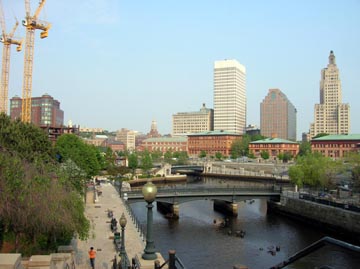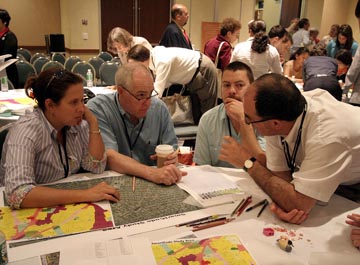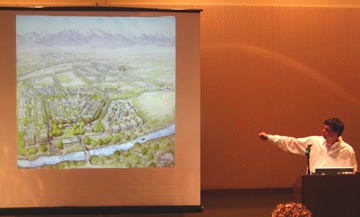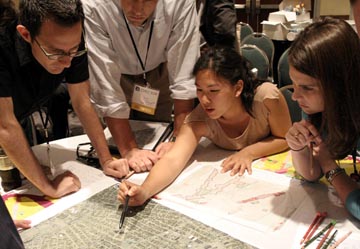From June 1st through 4th, a cadre of 1,500 students, professionals, intellectuals, and activists descended upon Providence, Rhode Island, for the Congress for the New Urbanism's (CNU) fourteenth annual conference, "Developing the New Urbanism: Implementation", covered by Planetizen Correspondent Mike Lydon.

Written by Planetizen Correspondent Mike Lydon
Given the conference theme, the rapid and ongoing transformation of "Downcity" (Providence's downtown district) provided a wonderful backdrop for the largest CNU conference to date. New Urbanist developer Buff Chace and his development company Cornish Associates, who are known as Providence's best stewards of urban revitalization, fittingly hosted the vibrant gathering with grace and alacrity.
Wednesday, May 31
Though the conference officially began on Thursday June 1st, a rapidly growing group of students and professionals called the "Next Generation" held their third annual meeting on Wednesday, May 31st. This one day conference, attended by 140 people, showcased numerous projects by young New Urbanist developers. Anna Lowder and Harvi Sahota kicked the day off with a discussion of their Duany Plater-Zyberk-designed Hampstead project in Montgomery, Alabama. Following Hampstead was a presentation on the Dover Kohl-designed South Main project, which is being developed in Buena Vista, Colorado, by brother/sister team Jed and Kate Selby. Lastly, Sarah Struever highlighted the work of PUENTE, a local non-profit development company that she founded, as well as other urban redevelopment projects in Providence.

After a brief lunch break, the Next Generation conference resumed with a highly interactive afternoon of "open space technology". Open space technology allows for diverse group discussions that grow out of topics suggested by individual Next Generation members. One of the most popular discussions was the issue of gentrification, affordable housing, and the role of New Urbanism -- all issues for which many young New Urbanists are increasingly sensitive.
Thursday, June 1
On Thursday morning, the conference kicked into high gear with New Urbanism 101 and 202 seminars, which focused exclusively on educating developers on the best practices for New Urbanist development. Several urban laboratories took place on Thursday as well, including the charrette-styled, "Coding Historic Providence: Calibrating the Smart Code to Local Conditions". Those not involved with these formal sessions had a chance to enjoy one of several tours either in Providence or of other urban locations in the New England region.
As the day came to a close, a reception for the first annual CNU New England Chapter design awards took place at WaterPlace Restaurant and Lounge, which features wonderful views of Providence's historic downtown and the recently restored river. The award reception was immediately followed by a warm welcome from Providence Mayor David Cicilline, and despite the sudden rain, an animated cocktail party ensued. Old and new members were able to meet, catch up, network, and celebrate a fruitful year for the New Urbanism.
Friday, June 2
The regular conference sessions got underway on Friday morning with a plenary session entitled "The New Urbanism and the Bottom Line". This plenary was organized in a talk show format, and featured three developers currently implementing projects using various principles of the New Urbanism. The rest of the day included such topics as "Capturing the Market for Modernism", "Advancing Urbanism through School Reform", and "New Urbanism and the Media". Despite this vast range of topics, the focus throughout the day was undoubtedly on how New Urbanism should be scaled up to meet the current demand, while not compromising the quality of the work implemented. The evening plenary session, "Urbanism at the Tipping Point: Perspectives from ULI and CNU" set out to answer some of the many questions raised by such a challenging task.
Marilyn Jordan Taylor, Chair of the Urban Land Institute (ULI) and a partner at Skidmore, Owings & Merrill, LLP, was the first speaker of the evening. Taylor's speech acknowledged the inevitability of population growth and the need for added density as our worldwide urban populations begin to outpace that of the rural. Taylor contextualized her thesis by stating that Hong Kong currently maintains 74,000 people per square mile, while New York City comes in at a mere 26,000 people per square mile. In short, Taylor posited that the biggest challenge to creating quality urbanism is to add density that is both humane andsustainable. To illustrate her point, she referenced projects in places like the Phillipines, and the recent work of the ULI in New Orleans.
Following Marilyn Jordan Taylor was CNU co-founder and intellectual leader Andres Duany. As soon as Duany began his lecture on the current state of the New Urbanism, his superior oratory skills stole the show. Though he partially agreed with Taylor's assertion that urbanism is indeed at a tipping point, he posited that "not all urbanisms are equal". Citing the superiority of the CNU as an elite, but open organization that is pragmatically engaged in the "business of the long run", Duany delivered a swift and impassioned Kunstlerian diatribe on the eventual futility of America's economic and social arrangements, the work of the CNU organization in a Katrina-torn Gulf Coast, the urban wonders of New York City, and the coming inevitability of the New Urbanism. Granted that Duany was preaching to the proverbial choir, the lecture was extremely well-received, and it seemed to leave the crowd feeling truly inspired.

Architect/planner Robert Alminana discusses his team's regulating plan (Source: Sandy Sorlien)
Saturday, June 3
Saturday began with the first of two weekend plenary sessions to honor New Urbanism's most influential predecessors with lifetime achievement awards. The first went to famed architect and theorist Christopher Alexander, author of A Pattern Language: Towns, Buildings, Construction. After humbly receiving the award, Alexander took to the stage and delivered a meandering, but honest and expected critique of New Urbanism. Calling New Urbanist developments "stiff" with "buildings that have no soul", Alexander quietly implored the New Urbanists to undertake a new process development via his method of "unfoldings" for building communities. Overall, the lecture was fairly well-received, but it was clear that many conference attendees familiar with Alexander's work had hoped for a more focused and instructive lecture on how his generative code theories can be applied to today's rapid pace of development. As for the developers, most of them were left simply confused.
The rest of the day brought a plethora of sessions and meetings that displayed the diversity of interests that exist within the CNU. One of the most interesting sessions was a two and a half hour "Gulf Coast Renewal" meeting. The well-attended session was the first full meeting between all of the charrette leaders since working on the famed "super charrette" along the Mississippi coastline. With participants having returned as many eight times since the first charrette, there was much to report on in a small amount of time.
The final plenary session of the day began with TV cameras and news reporters hovering as the Honorable John Prescott, Deputy Prime Minister of the United Kingdom, took to the stage. Prescott, who believes deeply in the tenets of the New Urbanism, yet does not consider himself a New Urbanist, gave an enthusiastic speech about sustainable community building in his home country. Despite his known political troubles, the audience gave him a standing ovation, perhaps thirsty for such thoughtful rhetoric by political leaders on this side of the Atlantic Ocean.

Next Generation developer Jed Selby presents South Main in Buena Vista, Colorado (Source: Jim Kumon)
Following Prescott was the Architecture critic Robert Campbell. Campbell paid tribute to the late Jane Jacobs and the gigantic influence she exerted over urbanists for the past half century. Campbell, who had several interactions with Jacobs over the course of her life, recalled her work fondly and consequently delivered an unfettered presentation, one which would not have embarrassed the incredibly modest Jacobs. Like Jacobs herself, it was classy and to the point.
The highlight of the evening came in the final lecture given by CNU co-founder Dan Solomon, entitled "Whatever Happened to Modernity?" Calling for a more holistic approach to urban design and architecture, Solomon delivered an absolutely brilliant speech on elegant modern design and its role throughout the early 20th century. By highlighting the work of his three heroes -- fashion designer Coco Chanel, jazz composer Duke Ellington, and the ballet choreographer George Balanchine -- Solomon was able to effectively illuminate the transformative properties of early modern innovation. By successfully making the connection between their work, the New Urbanism, and his own modern architecture and urban design, Solomon may have finally quelled the superficiality of the style wars that have long existed between traditional and modern aesthetes.
After Solomon finished his speech, he was honored with a standing ovation. Robert Campbell was apparently so touched by Solomon's words that he felt compelled to approach the microphone afterwards and publicly state, "that was the first thing I have ever heard at a CNU conference where I agree with every word of every sentence." It was a powerful moment.

Jenny An of Torti Gallas directs her team's coding strategy (Source: Sandy Sorlien)
Sunday, June 4
After celebrating late in to the cold, rainy night, a large crowd rose early on Sunday morning to witness architect and urbanist Leon Krier receive the second CNU lifetime achievement award at the final plenary session. Krier lectured on the shortcomings of what he calls "modern vertical sprawl", a.k.a. the Vancouverization of cities, and argued for the need to return to traditional urban form. Krier's speech clearly contrasted the words of Dan Solomon and Marilyn Jordan Taylor from the prior two evenings, but also demonstrated the wide diversity of opinion within the CNU that characterizes the constant evolution of this vital organization.
With an overall goal of educating those who have so much influence over our built environment -- developers -- as well as highlighting the many successful New Urbanist projects already built, this year's conference successfully focused on the challenge of making all development New Urbanist development. With an impressive variety of discussion topics, panels, urban laboratories, plenary sessions, debates, task force meetings, and several tours of New England's best examples of old and new urbanism, the CNU has positioned itself for future success.
Mike Lydon is currently pursuing his Masters in Urban Planning from the University of Michigan, concentrating in Physical Planning and Urban Design. This summer he will work for Duany Plater-Zyberk and Company in Miami, Florida.
You can learn more about CNU XIV at the Daily NUws, www.dailyNUws.com. In addition to reports from many of the sessions and events, it has a growing section with audio and video of CNU speakers and discussions.

Planetizen Federal Action Tracker
A weekly monitor of how Trump’s orders and actions are impacting planners and planning in America.

Restaurant Patios Were a Pandemic Win — Why Were They so Hard to Keep?
Social distancing requirements and changes in travel patterns prompted cities to pilot new uses for street and sidewalk space. Then it got complicated.

Map: Where Senate Republicans Want to Sell Your Public Lands
For public land advocates, the Senate Republicans’ proposal to sell millions of acres of public land in the West is “the biggest fight of their careers.”

Maui's Vacation Rental Debate Turns Ugly
Verbal attacks, misinformation campaigns and fistfights plague a high-stakes debate to convert thousands of vacation rentals into long-term housing.

San Francisco Suspends Traffic Calming Amidst Record Deaths
Citing “a challenging fiscal landscape,” the city will cease the program on the heels of 42 traffic deaths, including 24 pedestrians.

California Homeless Arrests, Citations Spike After Ruling
An investigation reveals that anti-homeless actions increased up to 500% after Grants Pass v. Johnson — even in cities claiming no policy change.
Urban Design for Planners 1: Software Tools
This six-course series explores essential urban design concepts using open source software and equips planners with the tools they need to participate fully in the urban design process.
Planning for Universal Design
Learn the tools for implementing Universal Design in planning regulations.
Heyer Gruel & Associates PA
JM Goldson LLC
Custer County Colorado
City of Camden Redevelopment Agency
City of Astoria
Transportation Research & Education Center (TREC) at Portland State University
Camden Redevelopment Agency
City of Claremont
Municipality of Princeton (NJ)


























